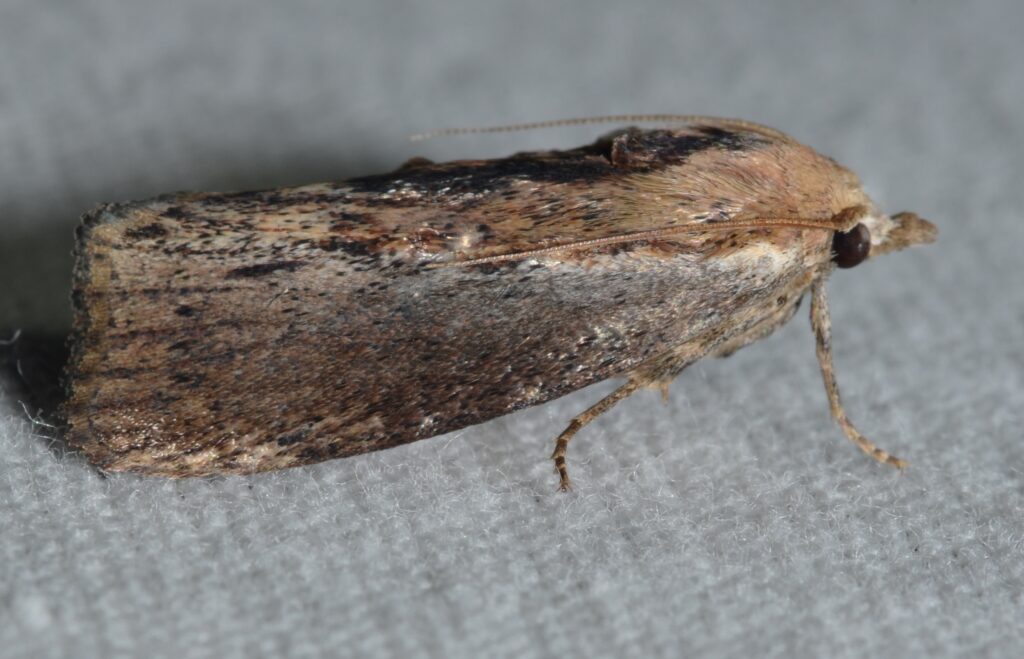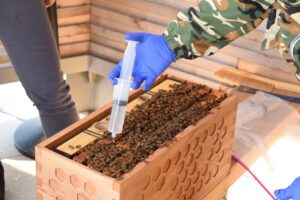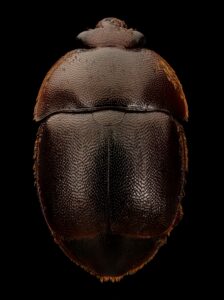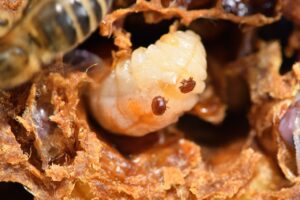Wax moths pose a significant threat to beekeepers worldwide, targeting honey bee colonies and causing damage to beeswax and comb structures. Understanding their life cycle, behaviors, and the signs of infestation is crucial for effective hive management and preservation of hive health. This article explores key aspects of wax moths, including their types, damage caused, prevention methods, natural predators, and effective treatment options.

Table of Contents
What are Wax Moths?
Overview of Wax Moths
Pests that primarily target honey bee colonies, causing damage to beeswax and honeycomb. They have distinct life cycles involving egg, larval, pupal, and adult stages, during which they can infest and weaken bee colonies.
Importance in Beekeeping
Understanding wax moths is crucial for beekeepers as these pests can severely compromise hive health and productivity. Wax moths primarily target beeswax and honeycomb structures, which are essential for the hive’s stability and function.
When infested, larvae of wax moths feed on beeswax, creating tunnels and weakening the comb. This damage can lead to the collapse of comb structures, making it difficult for bees to store honey and raise brood effectively. Moreover, the presence of wax moth larvae and their silk webbing can contaminate honey, reducing its quality and marketability.
Beekeepers must actively manage wax moth infestations through regular monitoring, preventive measures, and timely interventions to maintain strong and healthy bee colonies.
Species of Wax Moths
There are two main species of wax moths that affect beekeeping: the Greater Wax Moth (Galleria mellonella) and the Lesser Wax Moth (Achroia grisella). Each species exhibits similar behaviors but may differ in geographic prevalence and specific ecological preferences.
Impact on Bee Colonies
Wax moths present a direct and significant threat to bee colonies due to their destructive feeding habits and reproductive behaviors. When wax moth larvae infest a hive, they consume beeswax, which is crucial for constructing comb and storing honey and pollen. This consumption weakens the structural integrity of the hive, leading to compromised comb stability and structural collapse over time. As larvae feed, they create tunnels and webbing within the comb, further destabilizing the hive’s architecture and making it less hospitable for brood rearing and food storage.
Moreover, the presence of wax moth larvae and their activities can contaminate stored honey with silk and fecal matter, rendering it unfit for consumption or sale. This not only impacts the hive’s productivity but also diminishes the quality of hive products. In severe infestations, wax moths can overwhelm a colony, leading to decreased bee population, reduced honey production, and ultimately, colony collapse if preventive measures are not implemented promptly.
Effective management and prevention strategies are critical for beekeepers to mitigate the impact of wax moths on bee colonies. Regular hive inspections, maintaining strong and healthy colonies, and implementing integrated pest management techniques are essential to preserve hive health, productivity, and sustainability in beekeeping operations.

1. Lifecycle of Wax Moths
Egg Stage
During the egg stage, wax moths lay their eggs in cracks and crevices of beehives. These eggs are tiny and difficult to detect, making early prevention challenging for beekeepers.
Larval Stage
Once hatched, wax moth larvae begin to feed on beeswax, honey, and pollen within the hive. They create silk webbing as they move, which can encase and damage comb structures.
Pupal Stage
In the pupal stage, larvae spin cocoons typically outside the hive, often in protected areas nearby. This stage lasts several weeks as they undergo metamorphosis into adult moths.
Adult Stage
Adult wax moths emerge from their pupal stage and seek mates to continue the reproductive cycle. They are relatively short-lived, focusing on reproduction and laying eggs near beehives for the next generation.
2. Types of Wax Moths
Greater Wax Moth (Galleria mellonella)
The Greater Wax Moth is larger in size compared to its counterpart and is more commonly found in temperate regions worldwide. It lays eggs in beehives where its larvae feed voraciously on beeswax and pollen, potentially causing significant damage if left unchecked. This species is known for its resilience and adaptability, making effective hive management crucial for prevention.
Lesser Wax Moth (Achroia grisella)
The Lesser Wax Moth is smaller and typically prefers warmer climates. While less destructive than the Greater Wax Moth, it still poses a threat to beehives by consuming beeswax and disrupting colony activities. Beekeepers in regions with warmer temperatures must remain vigilant against infestations by implementing preventive measures and maintaining hive health to minimize their impact.
3. Damage Caused by Wax Moths
Consumption of Beeswax
Wax moth larvae feed voraciously on beeswax, which is essential for hive structure and storage of honey and pollen. This feeding weakens comb integrity and can lead to structural collapse if left unchecked. Beekeepers often find webbing and chewed-up comb remnants as signs of infestation, indicating the extent of damage caused by these pests.
Disruption of Colony Activities
As wax moth larvae consume beeswax and create silk webbing, they disturb the hive’s organization and cleanliness. This disruption can interfere with brood care, honey production, and overall hive health. Bee colonies under severe wax moth infestations may become weakened and less productive, affecting their ability to survive through winter or maintain robust populations.
4. Signs of Wax Moth Infestation
Webbing and Silk
One of the most visible signs of a wax moth infestation is the presence of silk webbing inside the hive. Wax moth larvae produce this webbing as they move through the hive, which can encase frames and comb, weakening the structure over time. Beekeepers often spot this webbing in corners and along the surfaces of frames.
Damage to Wax Structures
Another indicator of wax moth activity is the damage caused to beeswax structures. Larvae chew through wax comb, leaving behind tunnels and chewed-up wax particles. This damage compromises the structural integrity of the hive and can lead to further issues such as honey leakage and contamination. Regular hive inspections are essential to detect these signs early and take preventive measures.
5. Prevention Methods for Wax Moths
Hive Maintenance
Regular hive inspections and maintenance practices such as cleaning and repairing damaged comb help to minimize opportunities for wax moth infestations. Keeping hives in good condition reduces hiding places and prevents larvae from establishing themselves.
Strong Colonies

Maintaining strong and healthy bee colonies is crucial to wax moth prevention. A robust population of bees actively defends the hive and removes wax moth eggs and larvae. This includes ensuring sufficient food and pollen stores, managing queen health, and preventing stress factors that weaken colony strength.
Temperature Control
Maintaining optimal hive temperatures can deter wax moths, as they prefer warmer environments. Adequate ventilation and shading in hot climates help regulate hive temperatures, making them less favorable for wax moth infestations.
6. Natural Predators of Wax Moths
Predatory Insects
Several predatory insects, such as certain beetle species and parasitic wasps, target wax moth larvae and pupae. These natural enemies help control wax moth populations in beehives by hunting and parasitizing the larvae, reducing their numbers and impact on bee colonies.
Birds and Other Animals
Birds, particularly some species of birds like sparrows and swallows, are known to feed on adult wax moths and their pupae. Additionally, small mammals such as mice may consume wax moth larvae when they infest unprotected or poorly maintained hives. Encouraging these natural predators in the vicinity of apiaries can contribute to integrated pest management strategies for them.
7. Effective Treatment Options
Freezing
Freezing frames or hive components that are infested with wax moth larvae is an effective treatment method. This process kills the larvae and eggs without damaging the hive structure. After freezing, the frames can be thawed and returned to the hive.
Chemical Treatments
Chemical treatments, such as using acetic acid or paradichlorobenzene (PDB) crystals, are commonly used to control them. These treatments are applied according to manufacturer instructions and should be used with caution to avoid harming bees or contaminating hive products.
These treatment options help beekeepers manage wax moth infestations effectively, preserving hive health and productivity. Regular monitoring and integrated pest management strategies are essential to prevent reinfestation and maintain strong bee colonies.
Summary
Consisting primarily of the Greater Wax Moth and Lesser Wax Moth species, infest hives during their larvae stage, consuming beeswax and disrupting colony activities through silk webbing and structural damage. Early detection of infestation signs such as webbing and chewed-up comb remnants is essential for effective treatment. Preventive measures such as hive maintenance, maintaining strong colonies, and temperature control help mitigate infestations. Natural predators like predatory insects and birds contribute to integrated pest management strategies, complemented by treatments like freezing and chemical solutions to manage wax moth populations effectively
Other Resources
8 Common Beehive Pests and Effective Prevention Tips for Beekeepers
10 Effective Ways to Combat Varroa Mites in Your Beehive
Wax Moth Fact Sheet
Conclusion
Managing these pests requires a proactive approach from beekeepers, focusing on prevention, early detection, and strategic treatment. By implementing these strategies, beekeepers can safeguard their hives from wax moth damage, ensuring the longevity and productivity of their honey bee colonies. Regular monitoring and adaptation of techniques based on environmental conditions are key to maintaining healthy bee populations and sustainable beekeeping practices.



